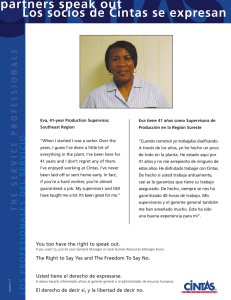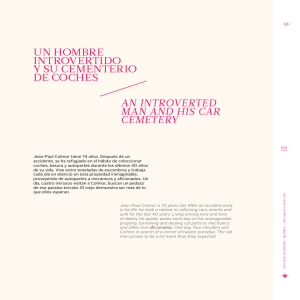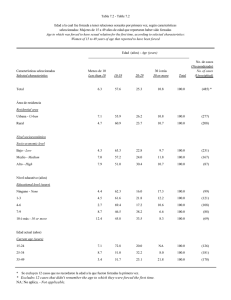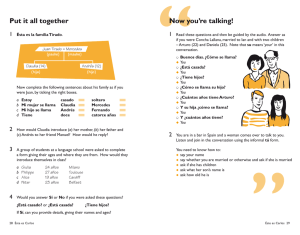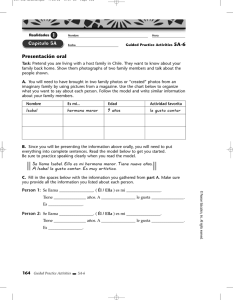Analyzing Spanish Temporal Expressions Expressing Age*
Anuncio
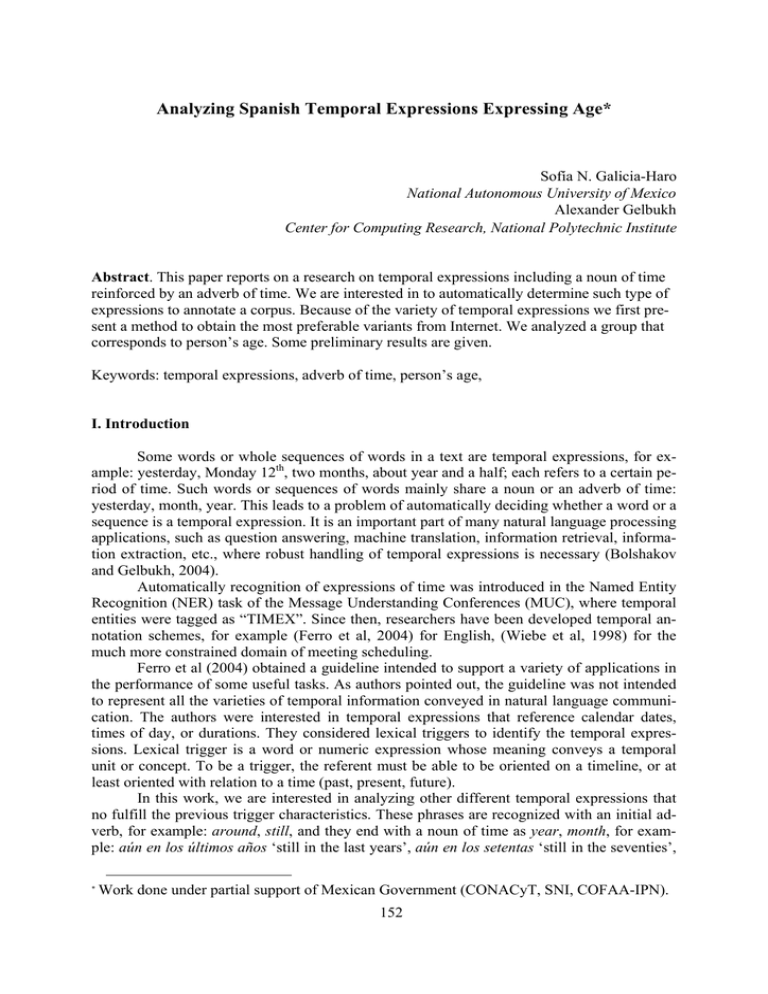
Analyzing Spanish Temporal Expressions Expressing Age*
Sofía N. Galicia-Haro
National Autonomous University of Mexico
Alexander Gelbukh
Center for Computing Research, National Polytechnic Institute
Abstract. This paper reports on a research on temporal expressions including a noun of time
reinforced by an adverb of time. We are interested in to automatically determine such type of
expressions to annotate a corpus. Because of the variety of temporal expressions we first present a method to obtain the most preferable variants from Internet. We analyzed a group that
corresponds to person’s age. Some preliminary results are given.
Keywords: temporal expressions, adverb of time, person’s age,
I. Introduction
Some words or whole sequences of words in a text are temporal expressions, for example: yesterday, Monday 12th, two months, about year and a half; each refers to a certain period of time. Such words or sequences of words mainly share a noun or an adverb of time:
yesterday, month, year. This leads to a problem of automatically deciding whether a word or a
sequence is a temporal expression. It is an important part of many natural language processing
applications, such as question answering, machine translation, information retrieval, information extraction, etc., where robust handling of temporal expressions is necessary (Bolshakov
and Gelbukh, 2004).
Automatically recognition of expressions of time was introduced in the Named Entity
Recognition (NER) task of the Message Understanding Conferences (MUC), where temporal
entities were tagged as “TIMEX”. Since then, researchers have been developed temporal annotation schemes, for example (Ferro et al, 2004) for English, (Wiebe et al, 1998) for the
much more constrained domain of meeting scheduling.
Ferro et al (2004) obtained a guideline intended to support a variety of applications in
the performance of some useful tasks. As authors pointed out, the guideline was not intended
to represent all the varieties of temporal information conveyed in natural language communication. The authors were interested in temporal expressions that reference calendar dates,
times of day, or durations. They considered lexical triggers to identify the temporal expressions. Lexical trigger is a word or numeric expression whose meaning conveys a temporal
unit or concept. To be a trigger, the referent must be able to be oriented on a timeline, or at
least oriented with relation to a time (past, present, future).
In this work, we are interested in analyzing other different temporal expressions that
no fulfill the previous trigger characteristics. These phrases are recognized with an initial adverb, for example: around, still, and they end with a noun of time as year, month, for example: aún en los últimos años ‘still in the last years’, aún en los setentas ‘still in the seventies’,
*
Work done under partial support of Mexican Government (CONACyT, SNI, COFAA-IPN).
152
alrededor de año y medio ‘about year and a half’, alrededor de hace 20 años ‘about twenty
years ago’.
The analysis of this type of expressions was motivated by our interest in extending the
range of annotation of temporal expressions. We found that this type of phrases present interesting cases, there is for example a group that describe person’s age. Automatically recognition of person’s age should be useful in question answering and machine translation tasks
among others.
In this article, we present the corpus-based analysis carried out to determine the length
of temporal expressions in Spanish reinforced by an adverb. First, we present the characteristics of the corpus we use as a resource of Spanish examples and the method we applied to obtain the materials for the analysis. Then we present the analysis of such phrases expressing
age of persons and their local context. Finally we present some conclusions.
II. Adverbs and Temporal Expressions
Adverbs of time (for example: before, today, after, tomorrow) create cohesion and coherence by forming time continuity in the events expressed in texts (Llido et al, 2001). They
are closely associated with narrative texts but they also appear in newspaper texts, for example: Senators will approve today in the morning a schedule for the debate, after the plenary
session the coordinators will meet to establish the regulation and tomorrow the tribune will
be liberated.
Researchers have been interested in adverbs of time included in temporal expressions,
for example (Ferro et al, 2004) considered some adverbs as: monthly, annual, semiannual. For
these temporal adverbs and frequency expressions like: per year, a year, they found that it is
often possible to discern the timeframe in which these sets occur, based on the document’s
context. Authors considered the adverbs: currently, lately, hourly, daily, monthly, ago as
Triggers and the adverbs: earlier, immediately, instantly, forthwith, meanwhile, as Nontriggers. Markable expressions are the expressions that should be annotated. To be markable,
the syntactic head of the expression must be an appropriate lexical trigger. Each lexical trigger is a word or numeric expression whose meaning conveys a temporal unit or concept, such
as “day” or “monthly.” Furthermore, to be a trigger, the referent must be able to be oriented
on a timeline, or at least oriented with relation to a time (past, present, future).
Works like that of (Ferro et al, 2004; Saquete & Martinez-Barco, 2000; Saquete et al,
2002) have been considered temporal expressions but no such we are interested in. We consider temporal expressions related to Spanish adverbs of time that mostly do not correspond
to triggers. We chose to analyze the Spanish temporal phrases that initiate with an adverb of
time (AdvT) and end with a noun of time (TimeN), for example:
aún a principios de los años 90 ‘still at the beginning of the 90s’
aún en nuestros días ‘still in our days’
aún hoy día, aún hoy en día ‘still nowadays’
alrededor de los 20 años ‘about 20 years’
alrededor de los años 20 ‘about the 20s’
These phrases present interesting issues, we could observe the relation between the
groups of words in the following examples:
1) A sus 80 años Juan tiene pulso de cirujano
2) Aún a sus 80 años Juan tiene pulso de cirujano
3) Hoy a sus 80 años Juan tiene pulso de cirujano
153
The sentences describe the same main fact: John, who is 80 years old, has surgeon's
pulse, but they tell us something else when we introduce a modifier (Carbonero, 1993) (aún
‘still’, hoy ‘today’) in each one: they argue for different conclusions.
2) Still at 80 years old, John has surgeon's pulse ⇒ in spite of his age he can have it
3) Today at 80 years old, John has surgeon's pulse ⇒ today he has it
The adverbs still and today make such conclusions obligatory and reinforce the meaning of time in different forms.
II.1 Materials
For our analysis, we selected the texts of four Mexican newspapers that are daily published in the WEB with a considerable part of their complete publication. The texts correspond to diverse sections: economy, politics, culture, sport, etc. from 1998 to 2002. The text
collection has approximately 60 million words (Galicia-Haro, 2003).
We wrote a program to extract the sentences matching the following pattern:
AdvT−something−TimeN
Where:
something − corresponds to a sequence of up to six words1 without punctuation
signs, verbs or conjunctions.
TimeN − corresponds to the following nouns of time: año ‘year’, mes ‘month’,
día ‘day’, hora ‘hour’, minuto ‘minute’, segundo ‘second’
AdvT
− adverbs of time, a collection obtained from (DRAE, 1995):
actualmente, adelante, ahora, alrededor, anoche, antaño, anteayer, anteriormente, antes,
aún, ayer, constantemente, cuando, de antemano, dentro, dentro de poco, después, en seguida, enseguida, entonces, finalmente, hasta este momento, hogaño, hoy, inmediatamente, instantáneamente, jamás, luego, mañana, más tarde, más temprano, mientras, mientras tanto,
momentáneamente, nunca, ocasionalmente, por horas, posteriormente, previamente, prontamente, pronto, recién, recientemente, siempre, simultáneamente, tarde, temprano, todavía, últimamente, una vez, ya
We extracted all sentences accomplishing the AdvT−something−TimeN pattern and
the TimeN−something−AdvT pattern since there could be phrases where the style changes the
word order, for example: año nueve meses después (lit. year nine months later). We found
83319 sentences beginning/ending with AdvT and ending/begining with TimeN, but 23566
sentences with the ‘something’ characteristics from a total of 3418375 sentences.
We found that some phrases have high frequency, for example: “antes de fin de año”
appears 161 times, “año más tarde” 106 times, etc. Other phrases are repeated with similar
words, for example: “actualmente de NUM años” where NUM considers numbers between 4
and 93. So, the different resulting examples are much more less than those corresponding to
23566 sentences.
3 Obtaining more Variants
Since our newspaper texts collection contains a subset of all possible phrases of this
type we analyzed a method to obtain a more representative group of phrases. Different possibilities exist to obtain such variants, we consider the following ones:
1
A larger quantity of words guarantee no relation between the AdvT and the TimeN
154
a) To look in other texts collections for examples of sentences that fulfill with the pattern earlier stated
b) To look for collocations of the nouns of time that we choose and to generate new
phrases with the above pattern
c) To look for examples in Internet
The first possibility is time consuming because it would imply individual texts searching since huge text collections do not exist in Spanish language available in entire form. For
the second option, since collocations are syntactic units we should also consider many combinations (adverb - adjective, adjective - noun, determinants, possessives, etc.). In addition,
synonymous are frequently used determined by the context and applied with certain freedom
designation skills.
On the other hand, the third option would allow us to find in less time phrases generated by native speakers including more common collocations. Nevertheless, we know that the
search in Internet bears problems as (Kilgarriff, 2007) has already compiled it, principally due
to the arbitrariness of the statistics of the searching machines, for example: the lacking pages
or the copies. We also know that the searching machines deliver different accounts still for
repetitions of the same question. Although this problem does not turn out to be so important
in this work, it is important that the results are being classified in accordance with complex
and unknown algorithms, so we cannot know what predispositions have been introduced.
With these considerations, we decide to use the search in Internet on the base that the used
examples are classified of an unknown form.
The main idea to obtain more examples from Internet is based on getting some examples from the newspaper texts, simplifying them (eliminating determinants, adjectives, etc.)
and searching variants by including the asterisk facility of Google (Gelbukh and Bolshakov,
2006). The whole procedure is showed in Figure 1. For example: for the phrase aún en su
primer año ‘still in his first year’ the string simplified becomes “aún en año” and the search is
“aún en * año” (see Figure 2) where asterisk substitutes the eliminated words. Google returns
the hits where there exist a string of words initiated by “aún en” then a sequence of words and
ending with “año”. For this example some results in the first ten pages are the following
phrases:
aún en aquellos años, aún en esos años, aún en muchos años, etc.
aún en siete años, aún en cien años, etc.
SEARCH(C)
For each phrase of type ADV-*-NounT or string-*-NounT in C
1) Obtain 100 examples from Internet
1.1) D = {examples excepting such where * includes verbs or punctuation}
1.2) Print D
2) Classify them according such words retrieved by *
3) For each group of phrases sharing words retrieved by *, assign a class Di
3.1) F = class Di
3.2) SEARCH(F)
UNTIL no new elements are obtained
Figure 1. Algorithm to obtain variants of temporal expressions
155
Figure 2. Google search for “aún en * año”
We could observe that some determinants, adjectives, and numbers were obtained.
An example for the whole procedure in Figure 1 is presented for the phrase aún en su
primer año:
SEARCH(“aún en * año”)
Step 1) 100 examples
estaba aún en 1585, año
Aún en ese año hace sus primeras grabaciones
sus lectores o autores no hubieran nacido aún en ese año.
descubiertas años antes y otras inéditas aún en aquel año. ...
absolutamente” es contra lo que vamos a luchar aun en Navidad y Año ...
Sin embargo, sugirió hacerlo con responsabilidad. Más aún, en un año de
reintegro del préstamo aún en aquel año sabático. ...
resaltó que es un paso importante para la ciudad, más aún en un año
con carácter de oficial para muchos, aun en 1790, año en que el
…
Step 1.1)
D= {
aún en ese
año
aún en ese
año
aún en aquel
año
aún en aquel
año
aún en un
año
aún en un segundo
año
aún en este último año
aún en pleno
año
aún en el
año
aún en pleno
año
156
aún en aquel
año,
…}
Step 2)
D= {
aún en ese año
aún en aquel año
aún en un año
aún en un segundo año
aún en este último año
aún en pleno año
aún en el año,
…}
Step 3) For each one of the classes a new process is initiated
SEARCH(“aún en ese * año”)
SEARCH(“aún en aquel * año”)
SEARCH(“ aún en un * año”)
…
For the first phrase “aún en ese * año” the search returns hits that brings phrases as:
“aún en ese mismo año”, “aún en ese último año”, etc. and the process is repeated in the same
way for each class. The process recurred several times until no new repeated phrases are obtained, determining the sequences of words that appear with higher frequency in order to
compile more variants of the initial phrase.
We have to notice that in addition some phrases not corresponding to a temporal
phrase were picked up, for example: aún en aquellos ambientes y años ‘still in those ambiences and years’, this type of phrases are eliminated in the manual identification at the end of
the total process.
In this work we manually get approximately five initial examples from the 23566 sentences. They correspond to the more numerous cases; i.e. for the cases where the AdvT is:
ahora ‘now’, antes ‘before’, aún ‘still’, todavía ‘still’, actualmente ‘nowadays’, alrededor
‘about’. We use those examples as the input of the method described in Figure 1, using the
Google search engine tool limited to Spanish language and the asterisk facility.
After this compilation of examples, the steps to automatically recognize these phrases
comprise a classification to obtain linguistic rules describing all examples. Then, a very accurate implementation of such linguistic rules is a Finite State Automata (Roche and Schabes,
1996) for each class. It is also possible to apply learning methods, for example, (Skut et al,
2005) describe a method of compiling ranked tagging rules into a deterministic finite state
device.
4 Phrases Denoting Age of Persons
Our purpose here is to analyze the temporal expressions as a starting point to interpret
them. The first filter we applied choose the examples containing “año” as TimeN, 5114 examples were obtained. From them we manually analyzed the examples corresponding to our
interest: the Spanish temporal phrases where an adverb makes some conclusions obligatory
and reinforce the meaning of time in different forms.
We found an interesting group of phrases denoting age of persons. Usually the age of
persons is described by Spanish temporal expressions including the time nouns años ‘years’
and meses ‘months’ (babies). They could be recognized in different ways: 1) with a string “de
edad” (‘old’ in English) after the word years, 2) a number after the person's name, delimited
157
by commas, 3) with the strings: la edad de, de edad de (‘the age of’, ‘of age of’, lit. in English) before the quantity of years.
However, there are other temporal expressions that describe the age of persons, for example: aún a sus 65 años, ‘still at his 65 years’, de alrededor de 20 años, lit. ‘of about 20
year’. These temporal phrases denote a point in the time line of a person; it could be a point in
the time line of the events related in the sentence or a point in a tangential time line.
We found that among these phrases, some of them preserve their meaning independent
of the context and others require some type of words in context to denote the age of a person.
Each one of the following phrases corresponds to a class of phrases indicating persons’ age that do not depend on context for the examples taken from newspapers:
aún a sus NUM años
aún hoy a sus NUM años
aún a tus NUM años
ahora a mis NUM años
aún con mis [pocos, cortos] NUM años
aún hoy con mis [pocos, cortos] NUM años
aún con {tus, sus} [escasos, casi] NUM años
aún con sus NUM años
, ahora de NUM años, (delimited by comma, parenthesis or using a final point)
where NUM represent numbers either by words or numerals, [] contain optional words
and {} indicate variants.
To confirm their meaning inside any context, we manually analyzed 100 examples
from Internet for every phrase (with an asterisk instead of NUM). See Apendix A for the
phrase “ahora a los NUM años”. For this group of phrases we show the results in Table 1,
where the last column called ‘Age’ corresponds to those examples denoting age of a person.
We present three columns describing the examples, where ‘#’ corresponds to the total number
of examples, ‘prev’ corresponds to the percentage of phrases sharing previous context (all examples appearing more than two times with the same previous context are grouped in this
column), and ‘post’ corresponds to the percentage of phrases sharing rear context.
Phrase
aún a sus * años
aún hoy a sus * años
aún a tus * años
ahora a los * años
ahora a mis * años
aún con mis pocos * años
aún con mis cortos * años
aún con tus casi * años
aún con sus escasos * años
aún con sus casi * años
aún con sus * años
, ahora de * años,
Examples
#
prev
59
21.8%
30
13.3%
4
0
18
0
0
0
1
0
2
0
0
0
1
0
8
0
38
16.7%
1
0
Age
post
26.8%
13.3%
0
16.7%
0
0
0
0
0
25%
21.9%
0
96.6%
100%
100%
83.3%
0
100%
100%
0
100%
50%
89.5%
100%
Table 1. Data for the phrases not depending on context
We could observe that most of the phrases confirm its independence from context for
the examples obtained from Internet (10 pages). The previous context considers phrases as
158
que ‘that’, quien ‘who’, etc. The rear context denoting age of person includes phrases like de
edad ‘of age’, de vida ‘of life’, cumplidos, que tengo ‘that I have’, etc.
But some phrases could have a different meaning, no related to person’s age. The rear
context includes phrases like de servicio ‘of service’, de experiencia ‘of experience’, de aplicación ‘of implementation’, de tradición ‘of tradition’, de antigüedad ‘of olden days’, de abandono ‘of carelessness’, de retraso ‘of delay’, de vigencia ‘of validity’, en el mercado ‘in
the market’, etc. The previous context includes phrases like vida útil ‘'life expectancy'’,
período ‘period’, etc. NUM in this case comprise numbers greater than 110 and fractions like
10.5, 3.5
For the other group, phrases indicating persons’ age that depend on context, each one
of the following phrases correspond to a class:
de alrededor de NUM años
actualmente con NUM años
actualmente de NUM años
actualmente de unos NUM años
ahora con [casi, más de] NUM años
ahora a NUM años
ahora a los NUM años
ahora de NUM meses
alrededor de NUM años
alrededor de los NUM años
To confirm their meaning with a specific context, we realized the same work previously described: we manually analyzed 100 examples from Internet for every phrase (with an
asterisk instead of NUM). See Apendix B for the phrase “ahora a NUM años”. For this group
of phrases we show the results in Table 2.
Phrase
de alrededor de * años
actualmente con * años
actualmente de * años
actualmente de unos * años
ahora con casi * años
ahora con más de * años
ahora a * años
ahora a los * años
alrededor de * años
alrededor de los * años
Examples
#
prev
33 33.3%
40
0
25
0
7
0
31
0
30
0
20
0
20
0
32
0
39
0
Age
post
0
45%
60%
28.6%
12.9%
0
0
0
0
38.5%
33.30
52.5%
68%
43%
61.3%
53%
0
90%
6.25%
66.7
Table 2. Data for the phrases depending on context
We could notice that half of the phrases have a meaning of person’s age in more than
60% of the examples but we could not confirm the dependence on context for most of the
phrases. Only for two phrases we could define a context for 45% and 60% of the examples.
For the first case the previous context considers words like: persona ‘person’, señora
‘misses’, niño ‘child’, joven ‘young’, chicos ‘boys’, etc. The rear context includes phrases
like vida útil ‘'life expectancy'’, de gobierno ‘of government’, de distancia ‘of distance’, etc.
NUM should not comprise numbers greater than 110 and fractions like 10.5, 3.5
159
The rest of the classes require a rear context like de edad ‘of age’, encima ‘above’, a
cuestas ‘on the back’, en sus espaldas ‘in his backs’, a las espaldas ‘to the backs’, a sus espaldas ‘to his backs’, to denote the age of a person.
We also found quasi fixed expressions like: actualmente cuenta con NUM años de
edad ‘at present it is provided with NUM years of age’ referring to the current age of a person.
There exist many examples including commas for almost all phrases that we neglected
in this work but a more conscious effort is required to analyze their context to define their
meaning. Also an analysis of the part of speech could precise the context for the phrases describing age of persons.
5. Conclusions
The variety in the structure of temporary expressions makes necessary the analysis of
different combinations of classes of words. We analyzed temporal expressions including a
noun of time that are modified by an initial adverb of time.
We present a method to enrich the variety of temporal phrases when only few examples are compiled. The method automatically brings more similar examples but since it does
not include complex tools, manually identification was performed at the end of the process.
The automatic identification of these phrases and their interpretation will directly
benefit natural language processing tasks as: response to questions; relation, characterization
and tracking of events; visualization of events in lines of time; generation of phrases; translation, etc. We found a group that could be interpreted as person’s age. For them we analyzed
the context of this type of temporal expressions to identify the phrases where its meaning is
context independent and to define the specific context for them.
References
Bolshakov, I.A., Gelbukh, A. (2004). Computational Linguistics: Models, Resources, Applications. IPN–UNAM–FCE, 186 p
Carbonero Cano, Pedro. (1993). Tiempo y aspecto en el adverbio (a propósito de "todavía",
"aún" y "ya") Estudios lingüísticos en torno a la palabra. Universidad de Sevilla, Facultad de Filología, 59-69
Ferro, Lisa; Laurie Gerber, Inderjeet Mani, Beth Sundheim and George Wilson (2004).
TIDES 2003 Standard for the Annotation of Temporal Expressions, MITRE Corporation.
Galicia-Haro, S. N. (2003). Using Electronic Texts for an Annotated Corpus Building. In: 4th
Mexican International Conference on Computer Science, ENC-, Mexico, 26–33.
Gelbukh, A., Bolshakov, I.A. (2006). Internet, a true friend of translator: the Google wildcard
operator. International Journal of Translation 18(1–2), 41–48
Kilgarriff, Adam. (2007). Googleology is Bad Science. Computational Linguistics 33 (1).
147-151
Llido, D., Berlanga. R. y Aramburu, M.J. (2001). Extracting temporal references to assign
document event-time periods. Lecture Notes in Computer Science, 2113, 62-71
DRAE, Real Academia Española. (1995). Diccionario de la Real Academia Española, 21 edición (CD-ROM), Espasa, Calpe
Roche, Emmanuel and Yves Schabes. (1996). Introduction to finite-state devices in natural
160
language processing. Technical report, Mitsubishi Electric Research Laboratories,
TR-96-13.
Saquete, E., y Martinez-Barco, P. (2000). Grammar specification for the recognition of temporal expressions. In Proceedings of Machine Translation and multilingual applications in the new millennium, MT2000, Exeter, UK. 21.1-21.7
Saquete, Estela; Patricio Martinez-Barco, Rafael Muñoz. (2002). Recognizing and tagging
temporal expressions in Spanish. In Workshop on Annotation Standards for Temporal
Information in Natural Language, LREC 2002
Skut, Wojciech; Stefan Ulrich, Kathrine Hammervold. (2005). A Generic Finite-State Compiler for Tagging Rules, Machine Translation, Vol. 18, No. 3, 239-250
Wiebe, J. M.; T. P. O’Hara, T. Ohrstrom-Sandgren, and K. J. McKeever. (1998). An Empirical Approach to Temporal Reference Resolution. Journal of Artificial Intelligence Research, 9, 247-293
161
APPENDIX A
Extract of the “ahora a los NUM años” examples
que se le diera y
no tendrán
derecho
a los objetivos del milenio,de
alerta de que la ESO
acabará
Y
de consumo de drogas es
cuando canta Amazing grace...
las escrituras, y son vacías. y
de riesgo se
detectan
Le caen las lágrimas, aún
Entonces,
cuando
ejercido la escritura, y lo
digo
nunca perdi la esperanza, y
y
pero
Le cuento que
un tercero ajeno, que
por alguna motivo, si es
son los
hombres
son los
hombres
Lo que sí
a kindergarten, p.1; Aquí y
obligatoria
concluye
cómo él veía el futuro, y más
cómo él veía el futuro, y más
, pero otra vez ,
hombre moderno
comienza
juzga él
Si
pasamos
gente a los cinco, diez, y
Educación Secundaria comienza
latina en la cancillería francesa,
era de 74 años, se
extiende
y la esperanza de vida
llega
pues se dice que se
adquiere
estimaciones serias,
empiezan
los tres añitos a un
insituto
tu hermanita siga siendo
igual
Vida sexual
inician
Ha
muerto
Siempre ha sido así, aún
se hacía antes a los 11 años y
disfruten de cosas
divertidas
a Ud. mismo a los 20 años ...
CONVENCION - CUSCO y
que
hablar
preocupaciones que
tengo
años conseguí el A1 y el B y
felizmente se
concretó
ahora a los diecinueve años
és Ingeniero Aeroespacial!
ahora a los dos años
íntegros de paro.
ahora a los 8 años
ahora a los 15 años
-ahora a los cinco años, lo hacía estupendamente
ahora a los doce años
, ¿reconocerán esto mediante
ahora a los siete años
,
ahora a los setenta años
,
ahora a los 8 años
,
ahora a los 65 años
, al explicar la muerte de
ahora a los veintisiete años
, antes que te hubieras
ahora a los 90 años
, con todo apasionamiento,
ahora a los casi 21 años
, consegui coger 1,
ahora a los 96 años
, desea que le suceda un
ahora a los 57 años
, el paso del tiempo ha de
ahora a los 97 años
, ella sigue asombrándonos
ahora a los nueve años
, en otro juicio distinto
ahora a los 19 años
, feliz sea
ahora a los veinticinco años
, gigantillos cansados, je
ahora a los veinticinco años
, gigantillos cansados, je
ahora a los 21 años
, mi papá dice que él nació
ahora a los 5 años
, p.2; Menos es Más, p.2;
ahora a los 16 años
, pero más del 70 de los
ahora a los 50 años
, por la certeza con que
ahora a los 50 años
, por la certeza conque lo
ahora a los seis años
, recaí pero el tumor ya n
ahora a los 80 años
, según concluyó un estudio
ahora a los cincuenta años
, una doble vida: la que le
ahora a los últimos 5 años
, vemos que el Frente Amplio
ahora a los quince años
, y ojalá llegué a los 25
ahora a los 12 años
, y se divide en Obligatoria
-ahora a los 69 años
ahora a los 77 años
.
ahora a los 77 años
.
ahora a los cinco años
.
ahora a los seis años
. Cada vez vemos niños más
ahora a los doce años
. Estoy muy preocupada :-(
ahora a los nueve años
. Habemos algunos otros,
ahora a los 11 años
. POR ESO ES IMPORTANTE
ahora a los 82 años
. Su camino en esta vida
ahora a los 88 años
. Su día comienza con
ahora a los 8 años
. Y los centros públicos
ahora a los 11 años
. saludos.
ahora a los 10 años
...
AHORA A LOS 17 AÑOS
ESTÁ DE RETORNO
ahora a los 41 años
al posar totalmente desnuda
ahora a los 34 años
caen dentro del tema AMOROSO
ahora a los 33 años
conseguí el A . Estoy
ahora a los año años
de Marabú destacó, y
162
APPENDIX B
Extract of the “ahora a NUM años” examples
Costumbres y frases del Perú de
ncia Nacional, han sido
condenados
y
Y
la edad penal anterior de 16
segundo juicio y fue
condenado
Con la nueva hipoteca ,
hablaba de Palestina y
empiezan
en 150 millones de euros de
de
pague
20 años desde 1950 y
llega
a la mayoría de edad,
rebajada
se encuentra el preso
condenado
que se puedan hacer de
cargos directivos, siendo limitado
ustedes tienen metas para de
y de sus técnicos, sobre todo ,
los Gigantes del area que
estan
Floriano se
enfrenta
pequeña historia que se
remonta
En fin ,
de las más disímiles edades, y
sobre el nivel del mar, y que
remedio, afirmó Suárez y aún
Judicial (CGPJ), se
enfrenta
quiso encubrir es
condenado
condenados
se
enfrenta
Rabasco se
enfrenta
Lo
sentencian
el hombre fue
condenado
estamos
Así que
Intentemos
proyectarnos
años y
está
Durango es
situados
cuestionada por su
situación
este lacerante indicador ,
en su tiempo ( que no
sucederá
visto
Eso,
viéndolo
hipermetropia demasiado fuerte ,
dijeron que moriría en prisión ;
de los niños y jóvenes
acceda
estamos
fueron absueltas, pero
recién
como lo hemos hecho
hasta
ahora a cuarenta años
ahora a cuatro años
-ahora a catorce años-ahora, a cien añosahora a 18 años
ahora a 28 años
ahora a 25 años
ahora a 60 años
ahora a tres años
ahora a cincuenta años
ahora a veinticinco años
ahora a 66 años
ahora a dieciocho años
ahora a doce años
ahora a cinco años
ahora a 5 años
ahora a 20 años
ahora a 35 años
ahora a mil años
ahora a cinco años
ahora a 21 años
ahora a 21 años
ahora a 42 años
ahora a 36 años
ahora a veintiocho años
ahora a cuatro años
ahora a 45 años
ahora a tres años
ahora a once años
ahora a 18 años
ahora a 168 años
ahora a 11 años
ahora a diez años
ahora a 122 años
ahora a treinta años
ahora a 1600 años
ahora a 91 años
ahora a 150 años
ahora a ocho años
ahora a tres años
ahora a 500 años
ahora a sesenta años
ahora a tantos años
ahora a mis 13 años
ahora a 57 años
ahora a doce años
ahora a cincuenta años
ahora a ocho años
ahora a tres años
163
.
de tu partida junto a
del nacimiento del autor, el
,
,
, era como si ya estuviese
, es tremendo, es un deuda
, importe que no es excesivo
, los latinos van a ser
, y él sabiendo que
, y se prevée que para 2050
.
.
. Ampliar
;
? Nadie levanta la mano.
El Galeón aquí está,
Luz de nosotros.
al frente de la cofradía
atrás. Por aquellos
de aquel suceso, gracias a
de aquella epopeya
de aquella maravilla salga con
de asesinado
de cárcel por
de cárcel por el abuso de
de cárcel).
de cárcel, aunque el juez
de cárcel, en lugar de los 12
de cárcel, sumando ya 393
de cárcel.
de conseguir los Objetivos de
de distancia, a los habitantes
de distancia de ese primer
de distancia de la Tierra
de distancia de la heroica
de distancia del nacimiento
de distancia y a sus 29 años
de distancia y después de
de distancia), el caos que el
de distancia, ese lenguaje
de distancia, fue
de edad tengo 14 dioptrias en
de edad y en pésima salud,
de escolarización, y que una
de ese fuego.
de esos procedimientos los
de gobierno las metas que
